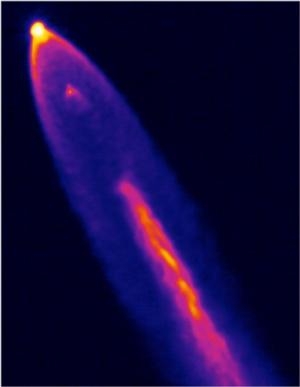Thermal Images Of Falcon 9 Spacecraft Captured During Descent In September
NASA successfully captured thermal images of a SpaceX Falcon 9 rocket on its descent after it launched in September from Cape Canaveral Air Force Station in Florida. The data from these thermal images may provide critical engineering information for future missions to the surface of Mars.

"Because the technologies required to land large payloads on Mars are significantly different than those used here on Earth, investment in these technologies is critical," said Robert Braun , principal investigator for NASA's Propulsive Descent Technologies (PDT) project and professor at the Georgia Institute of Technology in Atlanta . "This is the first high-fidelity data set of a rocket system firing into its direction of travel while traveling at supersonic speeds in Mars-relevant conditions. Analysis of this unique data set will enable system engineers to extract important lessons for the application and infusion of supersonic retro-propulsion into future NASA missions."
NASA equipped two aircraft with advanced instrumentation to document re-entry of the rocket's first stage. The first stage is the part of the rocket that is ignited at launch and burns through the rocket's ascent until it runs out of propellant, at which point it is discarded from the second stage and returns to Earth. During its return, or descent, NASA captured quality infrared and high definition images and monitored changes in the smoke plume as the engines were turned on and off.
"NASA's interest in building our Mars entry, descent and landing capability and SpaceX's interest and experimental operation of a reusable space transportation system enabled acquisition of these data at low cost, without standing up a dedicated flight project of its own," said Charles Campbell , PDT project manager at NASA's Johnson Space Center in Houston .
NASA's Scientifically Calibrated In-Flight Imagery (SCIFLI) project team at NASA's Langley Research Center in Hampton, Virginia , had their eyes, cameras and telescopes trained on the Falcon with the help of two long-range aircraft provided by NASA and the U.S. Navy.
A NASA WB-57, a twin jet engine high-altitude research aircraft from Johnson, was equipped with a long-range infrared optical system to capture the images. It is a unique full-motion video camera system that is gimbal-mounted on the nose of the WB-57. It collects full-color high definition and infrared video.
A Navy NP-3D Orion aircraft from the Naval Air Systems Command Weapons Division's Air Test and Evaluation Squadron-30 at Point Mugu, California , was equipped with a long-range infrared optical system and also took thermal images of the launch.
On launch day, the WB-57 and NP-3D Orion reached their observation locations about 50 miles from the projected rocket trajectory. After launch, the rocket emitted enough thermal energy for the plane's infrared cameras to catch a glimpse. Both flight crews then worked to obtain data as the first stage descended at supersonic speeds off the coast of Georgia .
"Through our partnership with SpaceX we're gaining access to real-world test data about advanced rocket stage design and retro-propulsion," said Michael Gazarik , NASA's associate administrator for Space Technology at NASA Headquarters in Washington . "Through this partnership we're saving the taxpayer millions of dollars we'd otherwise have to spend to develop and test rockets and flights in-house. This is another great example of American companies partnering with NASA to enable our future exploration goals."
This research and technology effort is funded by the Game Changing Development program in NASA's Space Technology Mission Directorate (STMD). STMD builds, tests and flies technologies needed for the aerospace missions of tomorrow and continues to solicit the help of the best and brightest minds in academia, industry, and government to drive innovation and enable solutions in important technology thrust areas. These planned investments address high priority challenges for achieving safe and affordable deep space exploration.
(Image provided by NASA)
 ANN's Daily Aero-Term (04.25.24): Airport Rotating Beacon
ANN's Daily Aero-Term (04.25.24): Airport Rotating Beacon ANN's Daily Aero-Linx (04.25.24)
ANN's Daily Aero-Linx (04.25.24) Klyde Morris (04.22.24)
Klyde Morris (04.22.24) Airborne 04.24.24: INTEGRAL E, Elixir USA, M700 RVSM
Airborne 04.24.24: INTEGRAL E, Elixir USA, M700 RVSM Airborne 04.22.24: Rotor X Worsens, Airport Fees 4 FNB?, USMC Drone Pilot
Airborne 04.22.24: Rotor X Worsens, Airport Fees 4 FNB?, USMC Drone Pilot



